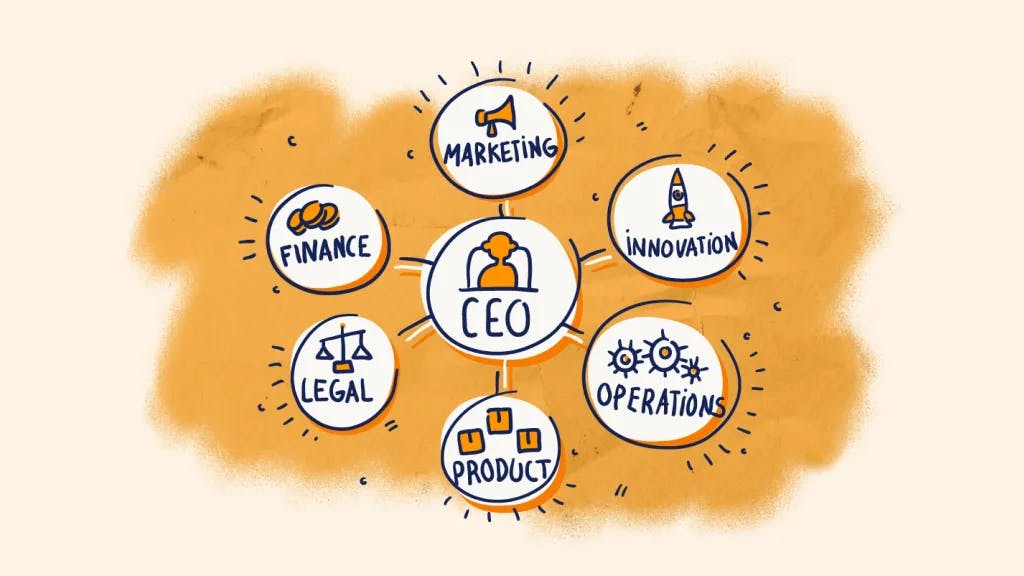Harnessing Disruptive Innovation: How Startup Scouting Can Propel Market Expansion for Growing Businesses
Unpopular opinion: fast-growing businesses are suffering. You may be wondering, They’re demonstrating growth in the middle of one of the largest tech industry crises in history. How on earth is that ‘suffering’...? Well, the situation goes beyond financial performance and market dominance.
Think of this: you’ve probably heard of mobile phones produced by Nokia. That’s the catch: you’ve heard of them, maybe even used them, but are not using them now. Once a brand that reigned over the industry, Nokia fell due to bureaucracy that hindered its capacity to take action, a harmful internal rivalry, and the inability to recognize the significance of lifestyle products such as the iPhone.
The truth is, the bigger you get, the more careful you become. Growing businesses are suffering because they gradually develop a lack of willingness to try something new, which can be counterintuitively risky as it potentially jeopardizes their position. In extreme cases, risk-aversion can cause an operational shutdown—something we saw happen to Nokia’s mobile phone product line.
In striking contrast, Apple started with PCs and later expanded into the smartphone market, becoming an undisputed trendsetter. The arrival of the iPhone is one of the definitive disruptive innovation examples, changing the very way people interact with their phones. The company has been reasonably consistent in its innovation efforts ever since—with one of the latest offerings being the Vision Pro mixed reality headset.
While millions of people have seen the company’s presentation by now, few know that Apple acquired an AR startup back in 2020, evidently in preparation for the great roll-out. Just a day after the presentation, Apple bought Mira, another startup that produces VR devices for businesses and the U.S. army. Both of these actions were the result of a startup scouting process, which plays a crucial role in disruptive innovation by acting as a bridge between the incumbents and the newcomers, helping companies not only release new product lines but also refine existing ones.
Understanding of Startup Scouting
Startup scouting means actively looking for early-stage companies with innovative ideas, technologies, or business models that align with your objectives. As an established company, you can unlock fresh perspectives, cutting-edge technologies, and entrepreneurial energy, fostering an environment of growth and adaptation.
What Is Startup Scouting?
Before embarking on startup scouting, it is essential to clearly understand what you hope to achieve through the process. This includes defining the specific areas or industries of interest, the type of innovation or expertise sought, and the outcome you expect to accomplish by engaging with startups.
The research and discovery stage involves extensive market research and analysis. You must explore various sources such as industry reports, startup databases, incubators, and accelerators. The idea is to gather information about startups that align with defined objectives and show potential for collaboration or investment.
Once you’ve compiled a list of potential startups, the next step is to screen and evaluate them based on predetermined criteria. You may want to factor in the startup’s business model, market traction, team expertise, intellectual property, and scalability. If everything checks out, consider yourself greenlighted for further engagement.
In the due diligence stage that comes next, you should focus on gaining a deeper understanding of the startup’s products, services, and capabilities. Some ways to do that are attending pitch events, meeting with founders, conducting interviews, and exploring potential synergies. Additionally—and this is very important—you should run legal and financial assessments to ensure a viable and strategic fit.
To validate the startup’s potential and grasp compatibility, you may want to initiate a Proof-of-Concept or pilot project. That way, you can collaborate on a smaller scale and test the feasibility and potential impact of the startup’s solution within the context of your organization.
If the startup successfully demonstrates the value and aligns with your objectives, the scouting process culminates in a partnership or investment. Finalization can take various forms, such as joint development, licensing agreements, strategic alliances, or even acquisition.
But if you think the scouting process ends there, you’re wrong. Continuous monitoring and iteration are necessary to assess progress, track key metrics, and adapt the engagement strategy. You must remain proactive in leveraging the startup’s innovations and continue nurturing the relationship for mutual growth.
Startup scouting is an iterative and ongoing process. As the business landscape evolves, you need to consistently scan the market for emerging startups and technologies to maintain a competitive edge.
Startup Scouting Approaches
If you don’t know where to start, we’d like to offer four approaches to startup scouting.
1. Industry-Specific Events and Conferences
Attending industry-specific events and conferences offers a valuable opportunity to scout for startups operating within a particular sector. These events often feature startup showcases, where entrepreneurs pitch their ideas and present their products or services. By engaging with these startups firsthand, you can evaluate their potential and establish connections for future collaborations or investments.
2. Incubators and Accelerators
Incubators and accelerators provide an environment for startups to grow and develop. Many established companies partner with these programs to gain access to a pool of early-stage startups. By becoming a mentor, or offering resources or funding, you can forge relationships with promising startups and potentially integrate their innovations into your operations.
3. Startup Databases and Online Platforms
The digital age has created numerous online platforms and databases—for example, Crunchbase—dedicated to startup ecosystems. These platforms curate and organize information about startups, including their industry focus, funding status, and key personnel. Thanks to these platforms, you can run targeted searches based on specific criteria, saving time and effort throughout the scouting process.
4. Collaborative Partnerships
Collaborating with other organizations, such as venture capital firms, angel investors, or innovation labs, can enhance your startup scouting efforts. If you leverage their networks and expertise, these partners can provide valuable insights, recommendations, and introductions to startups that align with your objectives. Collaborative partnerships foster a shared ecosystem where knowledge and resources are exchanged, increasing the chances of finding promising startups.
How Startup Scouting Speeds up Disruptive Innovations
According to a survey by Ernst & Young, 67% of respondents believe that companies should actively pursue potentially disruptive innovation projects, even if they carry risks and do not yield immediate returns. On that note, let’s now talk about the main point of startup scouting—accelerating disruptive innovation.
Firstly, startups are often driven by innovative ideas and disruptive concepts that challenge the status quo. With scouting, you get a chance to unveil these fresh perspectives and novel approaches that can lead to disruptive innovation theory turned into practice. Moreover, a culture of experimentation and agility is inherent to startups, enabling them to explore uncharted territory and develop disruptive solutions faster than established companies.
Secondly, startups are more agile compared to large organizations. They can swiftly adapt to market fluctuations and pivot their strategies to seize new opportunities. Once the partnership is struck, you can leverage the startup’s speed, flexibility, and ability to iterate rapidly, accelerating the innovation process and reducing time-to-market for disruptive solutions.
Another common feature of startups is that they are led by highly motivated and skilled entrepreneurs possessing specialized knowledge and expertise in their respective domains. Access to this entrepreneurial talent pool also enables you to tap into unique skill sets and accelerate the development of innovations.
What’s more, startups are at the forefront of technological advancements, leveraging emerging technologies and disruptive business models. Startup scouting can help you spot firms working on cutting-edge technologies such as Artificial Intelligence (AI), blockchain, the Internet of Things (IoT), and more. Partnering with these startups will allow you to harness such technologies, integrate them into your operations, and potentially drive disruptive innovations within your industry.
Last but not least, by working together, you can combine your strengths, resources, and expertise to develop a dedicated disruptive innovation strategy more efficiently. Startups bring fresh ideas and agile execution, while an established company provides market insights, infrastructure, scalability, and industry knowledge. This collaborative approach will speed up innovation and allow you to enjoy the best of both worlds.
Types of Disruptive Innovation
Having looked at startup scouting, we can now focus on the definition of disruptive innovation. In short, there are two major types: low-end and new-market.
Low-End Disruption
Incumbent market leaders often prioritize serving their most lucrative and demanding customers, continuously improving products and services to meet high expectations. As a result, they often overlook the needs of less demanding customers, whose requirements may be adequately met with simpler offerings. This creates an opportunity for disruptive companies, who can establish a foothold within the existing value network and target these low-end customers by providing a product that is ‘sufficiently good’ for their needs.
Once the disrupters have established themselves and built a customer base, they gradually move upmarket, progressively targeting higher market strata. This upward expansion enables them to challenge the incumbent companies that operate in the higher tiers and reshape the industry landscape.
New-Market Disruption
New-market disrupters embark on a unique path by creating markets where none existed before. They can transform non-consumers into consumers, essentially bringing about a previously untapped segment.
These players initiate new-market disruptions by establishing a presence within an entirely novel value network, unlocking latent demand and captivating the attention of customers who have previously lived without access to the product or service.
Disruptive Innovation Management Solution: Get Your Demo →
Examples of Disruptive Innovations
How do those categories reflect cases from the real world?
Ryanair
When Ryanair entered the market in the 1980s, the European airline industry was dominated by legacy carriers offering full-service flights at relatively high prices. This left a substantial segment of price-sensitive travelers underserved, especially those seeking affordable options for short-haul flights.
Ryanair identified this gap and strategically positioned itself as a low-cost alternative. It focused on minimizing costs across various aspects of its operations, including operating a single type of aircraft (Boeing 737s), negotiating favorable deals with airports, implementing point-to-point routes, and charging additional fees for extras like checked baggage or in-flight meals.
By adopting these cost-saving measures, Ryanair was able to offer significantly lower fares than its competitors. It appealed to customers primarily concerned with price and willing to forego traditional amenities and services in exchange for affordable air travel.
Ryanair disrupted the industry by providing a no-frills experience while maintaining punctuality and reliability. It targeted leisure travelers, budget-conscious individuals, and those seeking short-haul flights within Europe. The airline’s aggressive pricing strategy and relentless focus on cost efficiency allowed it to gain a considerable market share and expand its route network.
Ryanair’s success as a low-end disrupter influenced the European airline market. Legacy carriers were forced to reevaluate their pricing strategies and introduce their own low-cost subsidiaries or adjust their offerings to remain competitive in this price-sensitive segment.
Apple
Apple’s emergence as a new-market disrupter is a compelling example of how a company can successfully create a market where none existed. In their early days, computers were primarily large, sophisticated machines used by corporations and institutions. The idea of personal computing was virtually non-existent.
Recognizing the untapped potential of personal computers and envisioning a market beyond traditional boundaries, Apple set out to redefine the industry. The company aimed to make computers accessible to individuals, ultimately turning non-consumers into consumers. Apple understood that a vast segment of potential customers had never considered owning a computer due to various barriers such as complexity, high costs, and limited availability.
To address these obstacles and attract non-consumers, Apple pursued a different path. It focused on creating user-friendly interfaces and intuitive designs that would appeal to individuals with no technical background. This resulted in the introduction of the groundbreaking Macintosh, a personal computer that revolutionized the industry with its graphical user interface and mouse-driven interactions.
Furthermore, Apple targeted a different distribution channel by establishing its own retail stores. This move allowed the company to provide a unique customer experience, showcase its products, and offer personalized assistance to potential buyers. By creating an inviting and interactive environment, Apple effectively engaged with consumers who may have felt overwhelmed or uncertain about entering the world of personal computing.
How to Prepare for Disruption
The EY survey mentioned above also found 73% of respondents believe corporate disruption readiness will substantially impact their investment-related decision-making over the next three years.
Below are the top three things you need to know in order to brace yourself for the inevitable:
Listen to Your Customers and Observe Industry Trends
It is crucial to actively listen to your customers and stay attuned to industry trends. Engage in meaningful conversations with your customers to understand their evolving needs, pain points, and preferences. If you succeed in gathering insights directly from your customers, you can identify emerging patterns, spot potential disruptions, and anticipate shifts in the market. Additionally, closely monitoring industry trends, technological advancements, and market dynamics will help you stay ahead of the curve. Stay up-to-date with customer demands and industry developments and you will be able to proactively adapt your strategies and offerings to navigate disruptive forces effectively.
Focus on Business Model Innovation
In the face of disruption, embracing business model innovation is important. Rethink your existing business model and explore new approaches to create and deliver value to your customers. Traditional models may become obsolete as disruptive technologies and new entrants reshape industries. Analyze your current business model critically, locate areas of vulnerability, and seek innovation opportunities. Consider alternative revenue streams, partnerships, digital transformation, or other innovative strategies to help you stay competitive and capture new market opportunities. When you’re proactive and open to reimagining your business model, you can position yourself for success amid disruption.
Don’t Count on Breaking Through Right Away
Disruption often takes time, and it is vital not to expect immediate breakthroughs. Building momentum and gaining market traction in the face of disruption can be a gradual process. It requires persistence, resilience, and a long-term perspective. While you may have an innovative solution or a unique value proposition, it may take time for the market to fully embrace and adopt your offering. Be prepared for initial resistance, skepticism, or slow adoption rates. Focus on incremental progress, iterate based on customer feedback, and continuously refine your approach. Patience and perseverance are key when bracing for disruption, as success may come through steady progress rather than instant transformation.
Coordinate Your Innovation Strategy for Scale-Ups with InnovationCast
Innovation management software like InnovationCast plays a crucial role in supporting startup scouting and broader disruptive innovation efforts by:
Providing a centralized platform for capturing and organizing information about potential startups, allowing you to create a comprehensive database of startup profiles;
Facilitating collaboration and knowledge sharing among team members, enabling seamless communication, feedback exchange, and informed decision-making;
Including evaluation and assessment tools, allowing you to define criteria, rate startups, and track their progress;
Enabling ongoing monitoring of startups, providing alerts and notifications for critical milestones and market shifts;
Generating insightful reports and analytics, helping stakeholders gain a 360-degree view of the startup scouting process and the overall innovation portfolio.




